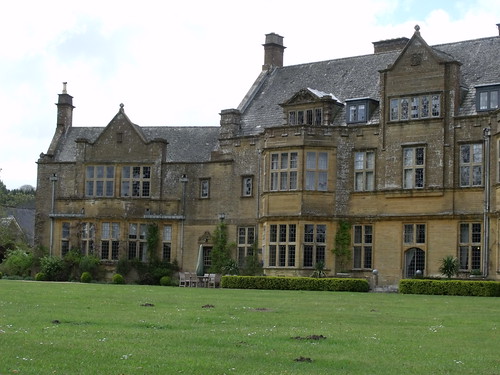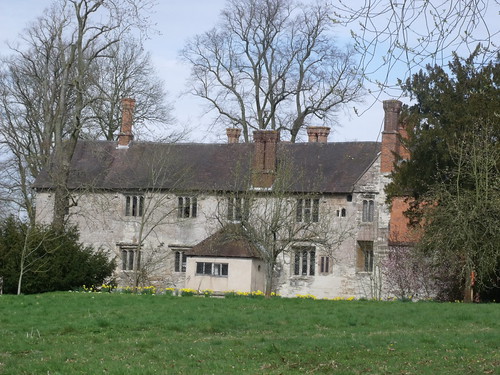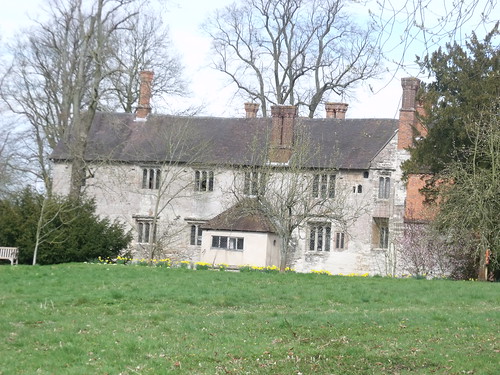Minterne House
Image by ell brown
This is Minterne House. It only dates from the early 1900s as the previous house on this site was demolished around 1900.
Was home of the Churchill family, later members of the Digby family.
Until the dissolution of the monastaries, Minterne was the Manor of the Abbey.
After 1539 it was given to Winchester College.
Winchester College rented it to the first Sir Winston Churchill, who left it to his son General Charles Churchill.
Admiral Robert Digby purchased the land in 1768.
The original Churchill House was demolished in 1900 because it had dry rot.
The house is Grade II* listed.
Minterne Magna House, Minterne Magna
ST 60 SE MINTERNE MAGNA MINTERNE MAGNA VILLAGE
(EAST SIDE)
8/165 7-4-76 Minterne Magna House
(formerly listed as
Minterne House)
GV II*
Country House, 1904-6 by Leonard Stokes for Lord Digby. Walls of
squared, coursed and dressed rubble and ashlar. Ham Hill stone
throughout. Stone slated roofs with stone copings and variously
positioned ashlar stacks. Free and eclectic use of styles, the
exterior being largely of 'perpendicular' gothic and 'Jacobethan'
derivation whilst the interior is largely baroque and 'Adamesque'
Plan: 2 storey main hall leading from a vestibule with other rooms
leading from spine corridors on both floors. Servants' wings (now
flats) to west and north. Billiard room set at an angle to main
range to the south-west. East tower of 4 storeys. Main range is
largely 2 storeys with attics. South front: symmetrical; 11 bays
plus billiard room wing. 3 canted bays of 2 storeys with 2 stone
gables between; rusticated and pilasters. 2 and 3-light stone,
mullioned and transomed windows; central round headed doorway with
keystone and bulls-eye window over; moulded cornice bearing carvings;
embattled parapet. North front: U-plan with central porch; plain
ashlar and rusticated pilasters. 2 storey hall windows to left of
porch of 3-lights with 'perpendicular' tracery under square heads;
similar first floor window over porch; other windows are stone
mullioned and mullioned and transomed under square heads with labels;
round porch hoods; embattled parapet with cornice below. East facade;
similar mullioned fenestration with 2 storey bow window; tower flanked
by capped, fluted pilasters. Internal features: hall in the baroque
style with a barrel-vaulted roof, coupled Ionic pilasters, a carved
wooden gallery; and an elaborately carved chimney piece in marble with
side-scrolls originally intended for Eaton Hall; tapestry room designed
to house tapestries by Judocus de Vos with reset allegorical ceiling
painting said to be by Thornhill and a reset C18 fireplace with key-
pattern inlay; other rooms with baroque and Adamesque decoration and
reset Cl8 chimneypieces.
Aslet, Clive, "Minterne Magna I and II", in Country Life, Feb 21st, 1980
pp 498-501 and Feb 28th, 1980 pp 574-7. Newman J and Pevsner, N,
Buildings of England: Dorset, Penguin, 1972, pp 295-6, Taylor, N,
Minterne House and Leonard Stokes, manuscript notes.
Listing NGR: ST6603204184
Four shots to make a panoramic
Baddesley Clinton - House and Moat
Image by ell brown
This is the house at Baddesley Clinton, surrounded by a moat. We only came for a walk around the grounds so didn't go inside.
The light wasn't that good in the afternoon, so I tried using the flash on my camera in Aperture mode (I keep getting dissapointed when some shots come out dark when I don't use flash - and thats usually when the sky is dull).
The house from the grounds at the back with daffodils. From the Wild Flower Meadow.
Baddesley Clinton House and the Bridge over the Moat is a Grade I listed building.
Manor house. Late C15, on earlier site; south-east range refronted c.1736: late
C19 service wing added to north-east side of south-west range designed and built
by Edward Heneage Dering. Courtyard plan. North-east range: stone ashlar; old
brick flues, bridge end stack to right with octagonal brick flue. 2-storey,
6-window range. Gatehouse at right of centre: 4-centred outer archway encloses
4-centred doorway with spandrels. Panelled and studded door to inner doorway.
6-light stone mullion and transom window to first floor. Battlemented parapet
to gatehouse. 2-light stone mullion window with 4-centre arched heads to
lights, at left of centre 3-light stone mullion window with 4-centre arched
heads to lights, at right,. 5-light stone mullion window to left of centre. Two
3-light stone mullion windows, with flat stone arches having keystones, to
left. Continuous hoodmould to right, and to left of centre. 4-light stone
mullion window to first floor right. 3-light stone mullion window to first
floor right of centre. 4-light stone mullion window to first floor left of
centre. Two 3-light stone mullion window to first floor left. South-east
range: red brick; old plain-tile roof; various brick stacks,with octagonal or
diagonally set brick flues, 2 storey A-window range. Irregular fenestration,
mostly of C18 three-light wood casements with segmental brick heads. south-west
range: stone ashlar; old plain-tile roof; various brick stacks. 2-storey,
6-window range. Irregular fenestration, mostly of 3-light stone mullion
windows. Single-storey addition to centre with hipped old plain-tile roof, has
2 round-arched blind recesses to moat. Wood casement window to ground floor.
Courtyard: irregular fenestration. Interior: entrance hall has close-studded
timber-framing to walls. Great hall has stone fireplace of decorative pillars
supporting a frieze and atlantes flanking rectangular panel with round heraldic
central panel with strapwork surroundings. Dining room has late C16 panelling
and carved wood fireplace with pillars supporting a frieze and with richly
carved central heraldic panel. Drawing room has C17 panelling and chimney piece
placed here C18 Henry Ferrers' Bedroom, also known as the state bedroom has
panelling and chimney-piece of c.1629. Other rooms also have panelling and
carved chimney pieces. Bridge. Early C18. Red brick. 2 round arches, plain
brick parapet. History: site held by the Clintons, then was bought by John
Brome in 1438. Held by the Brome family, and passed by inheritance to the
Ferrers family in 1517. Henry Ferrers (1549-1633) carried out much work at the
house.
(Buildings of England: Warwickshire: 1966, pp8l-82; Baddesley Clinton: national
Trust Guide Book, 1986)
(60)
Baddesley Clinton House and Bridge over the Moat - Heritage Gateway
Baddesley Clinton is a National Trust property.
Baddesley Clinton - House and Moat
Image by ell brown
This is the house at Baddesley Clinton, surrounded by a moat. We only came for a walk around the grounds so didn't go inside.
The light wasn't that good in the afternoon, so I tried using the flash on my camera in Aperture mode (I keep getting dissapointed when some shots come out dark when I don't use flash - and thats usually when the sky is dull).
The house from the grounds at the back with daffodils. From the Wild Flower Meadow.
Baddesley Clinton House and the Bridge over the Moat is a Grade I listed building.
Manor house. Late C15, on earlier site; south-east range refronted c.1736: late
C19 service wing added to north-east side of south-west range designed and built
by Edward Heneage Dering. Courtyard plan. North-east range: stone ashlar; old
brick flues, bridge end stack to right with octagonal brick flue. 2-storey,
6-window range. Gatehouse at right of centre: 4-centred outer archway encloses
4-centred doorway with spandrels. Panelled and studded door to inner doorway.
6-light stone mullion and transom window to first floor. Battlemented parapet
to gatehouse. 2-light stone mullion window with 4-centre arched heads to
lights, at left of centre 3-light stone mullion window with 4-centre arched
heads to lights, at right,. 5-light stone mullion window to left of centre. Two
3-light stone mullion windows, with flat stone arches having keystones, to
left. Continuous hoodmould to right, and to left of centre. 4-light stone
mullion window to first floor right. 3-light stone mullion window to first
floor right of centre. 4-light stone mullion window to first floor left of
centre. Two 3-light stone mullion window to first floor left. South-east
range: red brick; old plain-tile roof; various brick stacks,with octagonal or
diagonally set brick flues, 2 storey A-window range. Irregular fenestration,
mostly of C18 three-light wood casements with segmental brick heads. south-west
range: stone ashlar; old plain-tile roof; various brick stacks. 2-storey,
6-window range. Irregular fenestration, mostly of 3-light stone mullion
windows. Single-storey addition to centre with hipped old plain-tile roof, has
2 round-arched blind recesses to moat. Wood casement window to ground floor.
Courtyard: irregular fenestration. Interior: entrance hall has close-studded
timber-framing to walls. Great hall has stone fireplace of decorative pillars
supporting a frieze and atlantes flanking rectangular panel with round heraldic
central panel with strapwork surroundings. Dining room has late C16 panelling
and carved wood fireplace with pillars supporting a frieze and with richly
carved central heraldic panel. Drawing room has C17 panelling and chimney piece
placed here C18 Henry Ferrers' Bedroom, also known as the state bedroom has
panelling and chimney-piece of c.1629. Other rooms also have panelling and
carved chimney pieces. Bridge. Early C18. Red brick. 2 round arches, plain
brick parapet. History: site held by the Clintons, then was bought by John
Brome in 1438. Held by the Brome family, and passed by inheritance to the
Ferrers family in 1517. Henry Ferrers (1549-1633) carried out much work at the
house.
(Buildings of England: Warwickshire: 1966, pp8l-82; Baddesley Clinton: national
Trust Guide Book, 1986)
(60)
Baddesley Clinton House and Bridge over the Moat - Heritage Gateway
Baddesley Clinton is a National Trust property.
No comments:
Post a Comment